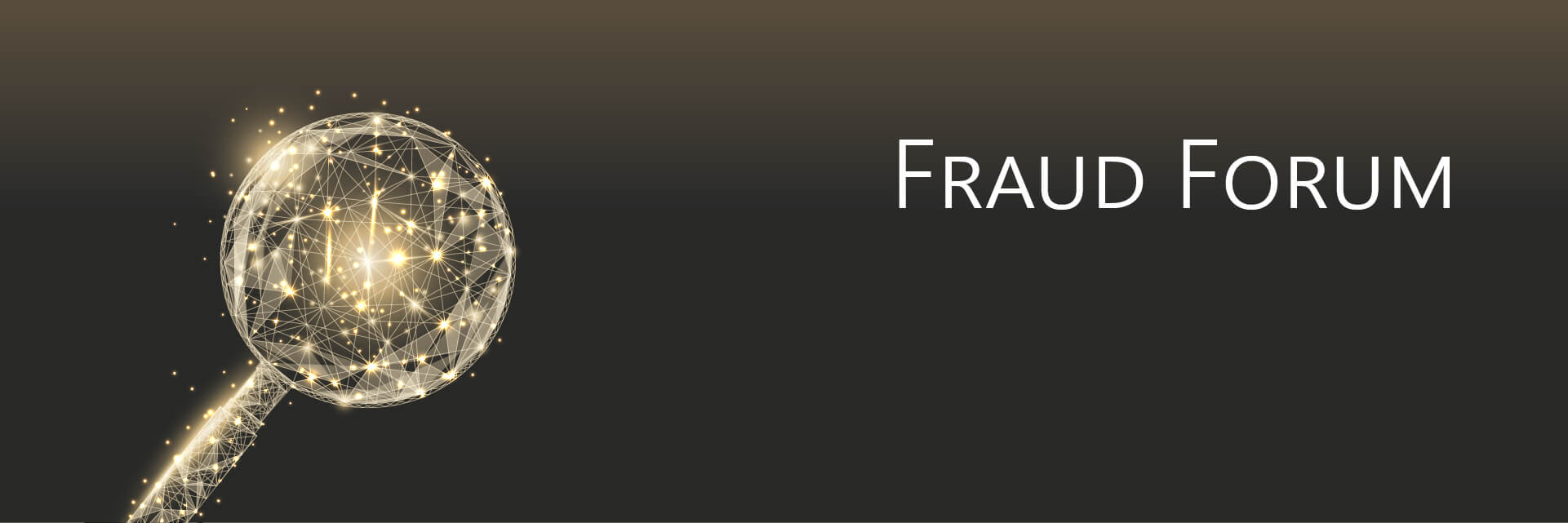
Occupational Fraud - Theft in the Workplace
- Published
- Nov 16, 2021
- Share
In this episode of Fraud Forum, Hubert Klein, Partner and Practice Leader for the Financial Advisory Services Group, and Jim Agar, a Managing Director in the Financial Advisory Services Group, discuss how theft and fraud occur in the workplace. Is your organization ready to combat occupational fraud?
Transcript
Jim Agar: Hello. And welcome back to another episode on the EisnerAmper Financial Advisory Services podcast series. I'm your host Jim Agar, and I'm a Managing Director with Eisner Advisory Group's Forensic, Litigation, and Valuation Services practice, better known as the FLVS Group. My guest say is Hubert Klein, who is my partner are here at Eisner, and an FLVS service area leader. Hubert has a tremendous amount of experience on today's topic, occupational fraud. As we continue with National Fraud Week, Hubert and I will be discussing occupational fraud and how to best prevent it. Hubert and I will be discussing occupational fraud and how best to prevent it. Hubert, welcome and thank you for joining me today.
Hubert Klein: Thanks for having me today, Jim.
JA: So the word fraud tends to spook people and lead them to imagine the worst scandals in history, ala Enron and Madoff, or they worry that a slight error in their books can lead to their arrest. Perhaps we should start off by discussing the term occupational fraud.
HK: Jim, absolutely. It is an area that scares a lot of business owners. First, we need to understand the definition. And the definition of fraud is really the intentional and methodical deception intended to result in financial gain. To break that down, it's the willful intent to deceive someone for monetary gain. That means that nobody who accidentally submits a wronged or corrects something or an entry is getting arrested, because mistakes do happen and they're natural in the business cycle. What is important is the person's intent. And that's why we talk about the willful intent to deceive for monetary gain. Occupational fraud, specifically, is fraud committed by one or more employees against their employer or an employer, and is one of the costless forms of financial crimes out there today.
JA: Yep. So a couple of good points, and I think you bring one forward that's very, very important to remember. Not every mistake and not every a misstatement is fraud. It really needs to have that element of intent. Piggybacking onto that, employees who are aware of a mistake or even responsible for a mistake or a misstatement, should not feel a reluctance to report or correct it because of potential criminal penalties. Again, that intent really does need to be demonstrated and present for fraud to exist.
HK: Absolutely. And I agree with you there. And pretty much, people need to understand that. What we're looking for here is willful acts with intent behind them.
JA: Sure. So moving on from the subject of intent, or what I think the criminologists might call [inaudible 00:02:45], let's talk about what it is that makes occupational fraud, when it does exist, so costly.
HK: It's a numbers game, Jim, and that's what it comes down to. Occupational fraud can happen in any type of business, small, medium, and large. And it happens all over the world. There's billions of people in the workforce. So just understand, that adds to the potential risk that's out there.
JA: Hubert, in our long careers in the business, we've both seen occupational fraud and its effects on employers, on vendor relationships, really on public perception. There've obviously been headline grabbing cases from time to time, where the damages have been in the billions of dollars. Thankfully, those matters are not occurring every day. But let's put those aside for a second and then talk about some estimates of how much fraud can cost the average business.
HK: Well, that's a good question, Jim. And really, the cost of occupational fraud depends on several factors. First and foremost, the length of which the fraud can occur or has occurred, the length of time. Obviously, the longer a fraud scheme goes on, the more time for the perpetrated to siphon money off from an organization. Studies show that the median duration of occupational fraud is around 14 months, which is over a year by two months. That's a long time for somebody to have access to steal funds from an organization. Another huge factor is how people are committing these frauds, with some instances being more common than others. But knowing that the 14 months, and what's going on is that the average loss sustained by an organization, according to the studies, is $1.5 million. That is a lot of money for any business. And it magnifies if you get into a small and medium business. It's certainly not a small number.
JA: Well, 14 months is certainly a long time for criminals to get away with that kind of crime. And $1.5 million can be, as you say, really huge for many organizations. What are these fraudsters doing for over a year in order to perpetrate their schemes?
Hubert Klein: Well, Jim, they're using a host of different types of schemes that are out there. What we're seeing is that there's really three branches of occupational fraud that we commonly know about and conceptually think about. The first one being asset misappropriation, then corruption, and then financial statement fraud. Those are the three main areas.
JA: Let's talk a little bit more about each one of them beginning with the last one you mentioned, which is financial statement fraud.
HK: Okay, absolutely. Financial statement fraud is the manipulation of the financial statements that either under or overstate the financial figures. It can be done in many ways by playing timing games with entries into the books and records, playing timing games with revenue recognition, creating fictitious accounts or vendors, or concealing or overstating expenses such as an expense reports and other types of things that may change the numbers for the bottom line revenue. And when we look at that, a lot of times we see it in revenue recognition because some people are incentivized that if they hit certain triggers or targets, they participate in bonus programs. So a lot of that will impact the bottom line on a financial statement.
JA: How about corruption, like conflicts of interest, and bribes, and illegal gratuities, extortion?
HK: Well, that is more common in financial statement fraud. And the corrupt is the second most common type of occupational fraud, because the options are much wider for the level of perpetrators that can actually do it. So think about when people quote, or we could say, grease the wheels in business, somebody's getting a bribe or a kickback, it's usually two more individuals involved in the corruption process. And that's the unique thing about corruption. It usually requires more than one perpetrator for corruption to happen. It could be two people within an organization and/or one person inside an organization and outside an organization.
JA: And then the third example that you gave of general types of occupational fraud is asset misappropriation, probably the easiest to understand.
HK: Yes, Jim, and as you know, it's the most common form of occupational fraud, and it's usually it can be split into two buckets, one being cash misappropriation, and then the other one could be the other assets, inventory, or other hard assets that a company may have. Cash misappropriation is when somebody actually has access to the cash or the checkbook, and they can take the money or find a way to take the asset and use it for their own personal gain and willfully do so. The taking of an asset such as inventory is another one. Hey, the warehouse is... I'll bait myself here, but the warehouse is full of radios. You know what? They're not going to miss one. There's a million in inventory. So if I take one, nobody's going to miss it.
Most people wouldn't take it, but somebody had the motivation to take it. And that's another form of asset misappropriation. The other one is using a business vehicle for personal use. The vehicle is owned by the business, insured by the business, only to be driven into and from business. And somebody's using it on the weekend to go to a Home Depot and load up on bushes for gardening and gets into an accident. So there's a whole host of different ways and a whole host of different schemes.
JA: Yeah. Even using your example, it doesn't even necessarily get into an accident. But if something like that becomes a common practice, you're talking about wear and tear, which is a cost to the business. And it's not a cost of business, but over time, it becomes a cost that the business is incurring. Many different variations on the same theme.
HK: Jim, you're head on. It could be anything as simple from taking copy paper and staples from the office supply room to somebody who actually has their hand on the checkbook or their cash and manipulates the accounts receivable or something else to put money into their own pocket. So it's a very broad area.
JA: A client of mine told me not that long ago that by switching from K-Cups in their coffee machines, over to the pouches, which are less commonly used in people's homes, he suddenly found people were drinking about 70% less coffee within his business. Were people actually drinking less coffee? No, because he was ordering and using roughly the same number of cups. It's just that the coffee pouches were not making their way into people's briefcase and pocketbooks, et cetera, because they couldn't be used at home the same way that the K-Cups had been. All of these things do have cost implications. So as we continue, something I'd like to point out is that of the three kinds of fraud that we just discussed financial statement fraud, corruption, and asset misappropriation, all of these can occur concurrently. Let's talk about the environment that must exist in order for occupational fraud to occur.
HK: Sure. Well, Jim, you're right. There's a host of things that have to happen in order for occupational fraud to occur, and all three main things. And they all have happens simultaneously. Basically, when someone decides to commit a fraud, there's three things that we look for. One is they have the opportunity to do it. They have access so there's an opportunity. Then they have I rationalization, which is, they justify to themselves that they're going to do it and it doesn't make a difference. And then the last one is going to be the pressure.
And we kind of talk about these as the three legs at a table of fraud. In order for someone to actually want to do it, usually it starts with a pressure, then there's that they have the opportunity, and then they rationalize it. Because if you don't have all three of them, technically you can't commit the fraud. You might want to steal money, but if you're not in a position to steal the money and misappropriate the asset, but you have the pressure, well, you don't have the opportunity. And they also might not have the rationalization. They might know that it's morally wrong and won't do it.
JA: Yeah. When discussing this concept, essentially the fraud triangle, those three elements you just talked about, the opportunity, the rationalization, and the pressure, I'd like to give an example of someone who has growing medical bills. They think they work incredibly hard at their jobs and they deserve more money than they're making. And one day, they have the chance to maybe do something like submit a large false expense report in order to quickly gain $2,000 or $3,000 without anybody double checking. That simple example incorporates the pressure rationalization and opportunity.
HK: That's exactly how it works, Jim. It also gets easier for the fraudster to continuously rationalize what they're doing the further they push and the more that they take because of those three issues. They have the opportunity, they have the pressure, and then they continue to self rationalize what's going on. One thing that your example demonstrates is that the person who is committing the fraud probably doesn't even think of themselves as a bad actor, or a thief, or a fraudster. And most don't. And the studies actually show that most people who commit frauds have no prior record or have done anything bad in their career. So that's why we talked about that triangle with the rationalization, the pressure, and the opportunity.
JA: Fraudsters don't necessarily look or talk are at like they're portrayed in the movies, right?
HK: When you interview people, you don't know what they are.
JA: Fair enough. Fair enough. So we've covered what occupational fraud is, how expensive it can be to business, and why people commit it. Hubert, here's the million dollar 14 month question that both of us have had from so many clients. How can my business guarantee that it is protected against fraud?
HK: Well, that's where our job gets really hard. Detecting fraud and, and quantifying how much it was. But trying to explain to our clients, there is a big difficulty in trying to let them know that fraud won't happen. We can't guarantee that as a practitioner. It could always happen in an organization. And that's one of the most important things. People need to be proactive and we can put in deterrents to help detect, and uncover, and quantify. Fraudsters or people who commit frauds also over time can morph. With technology, I kind of liken it to a radar detector. All right. And I'll take states where they're legal. Some states have radar detectors. Some law enforcement have radars that actually can detect whether you're using a radar, to which now, the electronics companies who makes both of those devices now develops a radar detector that can detect whether or not law enforcement has a radar detector that can detect if you're using radar and block it.
The same thing happens with fraudsters. As technology changes, they have changed, all right? With the internet, and wire transfers, and access to Zelle, and different apps, there's different ways they can manipulate and get things for their own personal gain. Years ago, I used to go into the petty cash box. Well, things have changed and people have put in controls. The reality is we can assist clients in designing, and implementing, and helping them install controls to minimize the risk of something happening. And also, probably minimize the risk of the length of which something may happen. And therefore, minimize the, the potential risk of a loss. But we can't guarantee that fraud will never happen.
JA: Certainly, that's quite a list of different ways that a business can attempt to protect itself or put in place methods to minimize that risk. None of these is really an immense order to do though, right?
HK: No, they're not. And I think that's the thing. It might be a heavy lift in the beginning to develop and understand the rules, and put the policies and procedures in place. But there certainly is a payoff down the road by helping the company preserve its financial assets and also protecting its reputation. The policies and procedures can certainly pay off in terms of preserving the company's financial assets and protecting them from reputational risk or issues of that nature. So a little money spent today can save a lot of money down the road.
JA: Unquestionably. The time to start thinking about these things is before an incident, and certainly not in response to one after money's gone out the door. In any event, Hubert, in closing, I do want to thank you for taking the time to sit with me today and giving such great it to our listeners on a topic that has the potential to profoundly touch really just about every business.
HK: It's been my pleasure, Jim, thanks for having me today.
JA: And thank you for listening to the EisnerAmper podcast series. Visit EisnerAmper.com for more information on this and a host of other topics and join us for our next EisnerAmper podcast, when we'll continue to get down to business.
Also Available On
What's on Your Mind?
Start a conversation with the team
Receive the latest business insights, analysis, and perspectives from EisnerAmper professionals.













